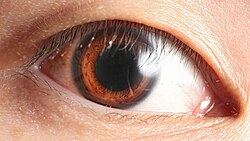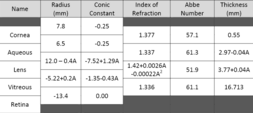
Back عين الإنسان Arabic ГӀадамасул бер AV Mata orang BEW Човешко око Bulgarian মানব চোখ Bengali/Bangla Ljudsko oko BS Sistema visual humà Catalan چاوی مرۆڤ CKB Lidské oko Czech ލޯ DV
| Human eye | |
|---|---|
 | |
 1. vitreous body 2. ora serrata 3. ciliary muscle 4. ciliary zonules 5. Schlemm's canal 6. pupil 7. anterior chamber 8. cornea 9. iris 10. lens cortex 11. lens nucleus 12. ciliary process 13. conjunctiva 14. inferior oblique muscle 15. inferior rectus muscle 16. medial rectus muscle 17. retinal arteries and veins 18. optic disc 19. dura mater 20. central retinal artery 21. central retinal vein 22. optic nerve 23. vorticose vein 24. bulbar sheath 25. macula 26. fovea 27. sclera 28. choroid 29. superior rectus muscle 30. retina | |
| Details | |
| System | Visual system |
| Identifiers | |
| Latin | oculus |
| MeSH | D005123 |
| TA98 | A01.1.00.007 A15.2.00.001 |
| TA2 | 113, 6734 |
| FMA | 54448 |
| Anatomical terminology | |
The human eye is a sensory organ in the visual system that reacts to visible light allowing eyesight. Other functions include maintaining the circadian rhythm, and keeping balance.

The eye can be considered as a living optical device. It is approximately spherical in shape, with its outer layers, such as the outermost, white part of the eye (the sclera) and one of its inner layers (the pigmented choroid) keeping the eye essentially light tight except on the eye's optic axis. In order, along the optic axis, the optical components consist of a first lens (the cornea—the clear part of the eye) that accounts for most of the optical power of the eye and accomplishes most of the focusing of light from the outside world; then an aperture (the pupil) in a diaphragm (the iris—the coloured part of the eye) that controls the amount of light entering the interior of the eye; then another lens (the crystalline lens) that accomplishes the remaining focusing of light into images; and finally a light-sensitive part of the eye (the retina), where the images fall and are processed. The retina makes a connection to the brain via the optic nerve. The remaining components of the eye keep it in its required shape, nourish and maintain it, and protect it.
Three types of cells in the retina convert light energy into electrical energy used by the nervous system: rods respond to low intensity light and contribute to perception of low-resolution, black-and-white images; cones respond to high intensity light and contribute to perception of high-resolution, coloured images; and the recently discovered photosensitive ganglion cells respond to a full range of light intensities and contribute to adjusting the amount of light reaching the retina, to regulating and suppressing the hormone melatonin, and to entraining circadian rhythm.[1]
- ^ Zimmer, Carl (February 2012). "Our Strange, Important, Subconscious Light Detectors". Discover Magazine. Retrieved 2012-05-05.